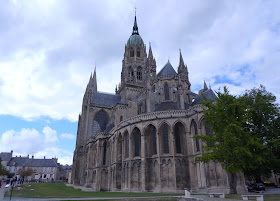The Explorer continued speeding to the French coast of Normandy. At about 9:00am on September 26th we reached the lock at Ouistreham, which connects the sea to the "Canal de Caen à la Mer," a six-mile channel that leads to Caen.
The early morning light gave Ouistreham a cheerful, fresh-scrubbed countenance.
The canal required us to take aboard a local pilot.
We passed by the new Pegasus bridge, a replacement built in 1994 for the bridge seized in 1944 by British paratroopers. We will visit this more closely tomorrow.
We slowly glided up to the dockside in Caen.
Lunch was served aboard ship, and then there was a choice of three afternoon tours; we had all signed up for our choice a few days before so that Lindblad could work out the logistics. We could have gone to Honfleur, a picturesque port on the south bank of the Seine, or to Bayeux to see the Bayeux Tapestry, or to the Chateau de Balleroy, a residence and balloon museum owned by the family of Malcom Forbes. Joan and I chose the Bayeux Tapestry, a nearly 70 meter (230 foot) embroidered cloth depicted the events leading up to the Norman conquest of England in 1066. It was sewn just a few years after William the Conqueror's victory.
This map will give you an idea of the relationship of Ouistreham, Caen, and Bayeux.
View Larger Map
Our group boarded the bus and we drove to Bayeux. Unfortunately but understandably, no photography of the tapestry was allowed. On our walk to the museum, we passed this waterwheel.
We regrouped in the courtyard of the museum while our guide acquired tickets.
I have downloaded -- thank you Google Images -- this image of how the tapestry is displayed. It wraps around in a long arc, so that you exit not far from the entrance.
Instead, we chose to check out exhibits on other floors about the tapestry, its history, and life in that era. We had already seen a video about the tapestry on board the Explorer before coming to the museum, and that helped. Even if we hadn't spent as much time with the tapestry as we would have preferred, we were glad to have come.
A short stroll from the museum is the Bayeux Cathedral, consecrated in 1077 on the site of even earlier Roman temples. Arriving from the museum a walker's first perspective is of the cathedral's back.
We continued to and entered from the front.
Here we are standing in the entryway looking down the length of the cathedral. In a quiet interior such as this it was very beneficial to have the guide equipped with a radio/microphone and us with receivers.
The altar area with its stained glass was well lit this day.
The window on the far right, and only that window, had cobwebs illuminated by the stained glass.
I'd never seen colored webs before. Perhaps they are favored by artistic spiders? Or devout ones?
The crypt below the cathedral also dates from the 11th Century, and is vaulted in the original Romanesque style, in contrast to the newer Gothic cathedral. According to our guide, after a while the crypt was forgotten, until workers preparing yet another burial in the floor of the cathedral uncovered the opening. There wasn't a lot of light for my camera ...
After leaving the cathedral the group split up. Joan and I explored some of the town, and were barely able to pass by a patisserie without stepping inside. Here's a view of our walk along the Rue Saint-Malo.
Then it was time to return to the parking area at the tapestry museum, and our bus. Soon after our return to the ship a double rainbow was spotted from the stern deck. The one in the center of the photo is bright, and there is a fainter one to the left ... click to enlarge and look along the horizon line.
Zooming in created this interesting shot.
That evening the second half of The Longest Day was shown, giving us more background on what we would see tomorrow in Normandy.



















No comments:
Post a Comment
Comments may not appear immediately as they are moderated by the author to eliminate spam. Please, no commercial links!